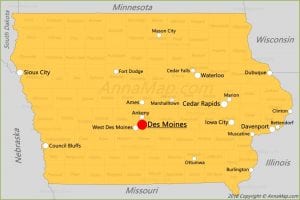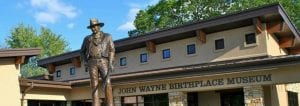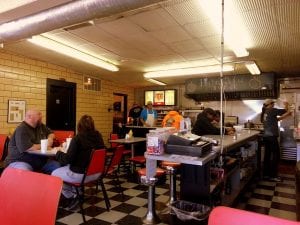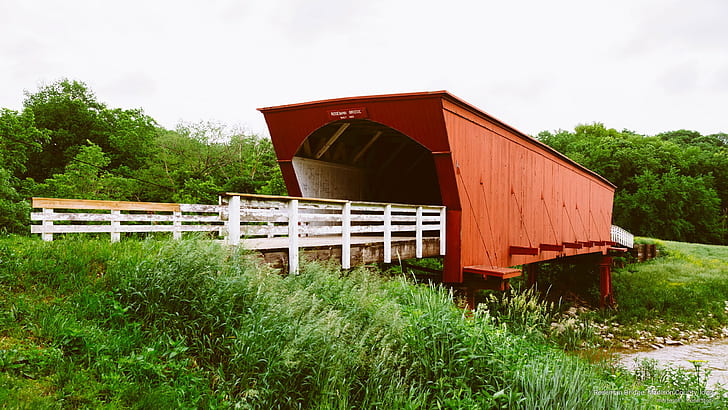
Day 45: In Iowa, A Tale of Two Fields
May 3, 2021
Day 43: Plowing Through Kansas and Nebraska
May 1, 2021Most recently updated on February 14, 2024
Originally posted on May 2, 2021
An interesting day ahead.
One more stop in Nebraska before we venture into Iowa for windmills, famous bridges and presidential political gatherings.
We begin Day 44 of our journey by hopping onto Interstate 80, our first taste of this cross-country highway.
This east-west freeway travels from San Francisco to Teaneck, New Jersey. It’s 2,906 miles long, the second longest interstate highway in the country. Only Interstate 90 is longer and only by 176 miles.
I-80 glides through 11 states and passes through Oakland, Sacramento, Reno, Salt Lake City, Des Moines and Toledo. Its straightest stretch is 72 miles just west of Lincoln. Its highest point is in Wyoming between Laramie and Cheyenne at 8,640 feet. That’s actually part of our route in about a week.
Interstate 80 was designated in 1956 as one of the original routes on the Interstate Highway System. It closely follows the route of the Lincoln Highway, the first cross-country road for automobiles. The freeway also incorporates part of the Oregon Trail across Wyoming and Nebraska as well as the California Trail in Nevada and California. It also follows the approximate route of the Transcontinental Railroad.
————————————-
We spend an hour on Interstate 80 east until we reach Omaha, a city known for meat, a host of inventions, college baseball and a number of famous athletes, actors and business owners. It also has its place in “Wizard of Oz” history.
The city in eastern Nebraska sits along the Missouri River next to the Iowa border at an elevation of 1,060 feet.
It’s the most populous city in Nebraska with nearly 480,000 residents. The population is listed as 65 percent white, 15 percent Hispanic or Latino and 12 percent Black.
The area was originally inhabited by the Omaha and Ponca tribes. Early European settlers included fur traders as well as Latter-Day Saint followers who set up a winter camp in 1846.
The town was eventually founded in 1854 by folks from Council Bluffs, Iowa, who used William Brown’s Lone Tree Ferry to cross the Missouri. There were many land speculators among the original settlers.
Omaha developed into a transportation hub due to its central location as well as steamboats that chugged down the Missouri. In the 1860s, stage coach lines and freight wagon trains traveling to Denver came through.
Railroads emerged in the 1870s and 1880s. In fact, the eastern end of the Transcontinental Railroad started here when Union Pacific workers began laying down tracks in 1865. There is a monument to “Mile Zero” across the river in Council Bluffs.

The College World Series is played every summer in Omaha. Photo by the Portland Press Herald.
Buffalo Bill’s Wild West Show was founded in Omaha. William Cody’s first performance was here on May 19, 1883.
The World’s Fair was held here in 1898. It was called the Trans-Mississippi & International Exposition. The fair was staged on 184 acres on the northern edge of Omaha from June 1 to October 31. There were 11 large white buildings and dozens of smaller buildings that surrounded a lagoon. An Indian Congress was held that attracted 500 members from 35 native tribes. President William McKinley spoke at the expo on October 12 with 110,000 in attendance. Overall, more than 2 million people attended, far less than the 27 million at the 1893 Chicago’s World Fair.
Breweries and meatpacking industries sprung up in the latter portion of the 1800s. Irish, German and Jewish immigrants arrived and were joined by African-Americans fleeing the South. Racial and labor tensions eventually arose.
The Omaha Stockyards were established in 1883, encouraged by a Wyoming rancher who wanted to reduce his livestock trips to Chicago. The stockyards drove Omaha’s economy for the next 80 years as cattle owners from 20 states brought their livestock here.
In the 1950s, half of Omaha’s workforce was employed in the meatpacking industry. The city surpassed Chicago in 1955 as the world’s top livestock market. In 1957, there were 19 meatpacking companies and 40 commission firms.
The stockyards declined in the 1970s and 1980s. It closed in 1999.
Meatpacking and food processing, however, remain a major part of the local economy, including the well-known Omaha Steaks company.
Another major employer is the Offutt Air Force Base, which is home to the 55th Wing, known as the Fightin’ Fifty-Fifth. About 32,000 people work here, including 8,000 military members. The base has been the headquarters of the Strategic Air Command since 1948. President George W. Bush was transported here after the September 11, 2001 attacks.
Four Fortune 500 companies have their headquarters here. The best known is Berkshire Hathaway, which is owned by Warren Buffett. Buffett, known as the “Oracle of Omaha,” was born here and has lived in the same house since 1958 that he purchased for $31,500. It’s worth about $1.4 million now.
The Mutual of Omaha insurance company is headquartered here along with Union Pacific railroad and the Kiewit Construction Company. Mutual of Omaha broke ground in January 2023 on a new 44-story tower downtown that will serve as its headquarters when it is completed in 2026.
Omaha is also home to the College World Series, which has been played here since 1950. The 2022 baseball championship was played in late June at Charles Schwab Field with the University of Mississippi capturing its first title in the tournament. Louisiana State University won their seventh World Series title in 2023.
The Nebraska metropolis has also been the site of an array of inventions. They include the bobby pin and pink hair curler by Tip Top, the Reuben sandwich from a chef at the Blackstone Hotel, Butter Brickle ice cream, Raisin Bran from the Skinner Macaroni Company and the t-v dinner, which was introduced by Swanson & Sons in 1954.
In addition to Buffett, there are number of homegrown celebrities from Omaha.
Dancer Fred Astaire was born here as was Major League Baseball Hall of Fame pitcher Bob Gibson. Actor Marlon Brando and activist Malcolm X also hail from Omaha.
Finally, Omaha was the hometown of the wizard in the “Wizard of Oz” movie. As he drifts off near the end of the film, you can see the words “State Fair Omaha” on his hot air balloon.
Intriguing Iowa
We sail across the Missouri River on Interstate 80 and enter Iowa.
The Hawkeye State, named after chief Black Hawk of the Sauk tribe, is the 23rd largest state at almost 56,000 square miles, actually bigger than Illinois and Florida.
Its population of more than 3 million ranks 31st, just ahead of Nevada and slightly behind Utah. The populace is listed as 84 percent white.
Iowa also has a mean elevation of 1,100 feet, putting it 23rd among states.

The first Europeans to visit were French explorers in 1673. The territory became part of the United States in 1803 with the Louisiana purchase.
White settlers stayed away for decades until the rich top soil finally lured farmers from Indiana, Ohio and Tennessee. Iowa has some of the most productive farmland in the world.
Farming has always driven the economy here. About 85 percent of Iowa’s land is used for agriculture. The state is first in corn production as well as in pork production. It’s second in soybeans, behind only Illinois.
It is by far the leading state for hogs and pigs. It has 23 million of them, well more than twice runner-up Minnesota. Iowa also ranks first in red meat production.
Iowa is also second in wind energy, behind only Texas. Wind, in fact, is responsible for 73 percent of Iowa’s electricity, the highest percentage of any state.

Iowa is the second leading state in wind energy. Photo by the Des Moines Register.
We see a lot of windmills as we cruise along Interstate 80 through the heart of the state.
Many of those tall turbines sit on farmland. They’re popular with a number of farmers because they don’t take up much land and the farmers don’t have to do anything except collect the monthly checks from the wind energy firms.
A prime spot for wind energy is the town of Walnut, a community of 720 people that is 45 minutes east of Omaha along Interstate 80.
There are more than 100 wind turbines in fields and farms in this region.
One of the first large-scale operations was the Walnut Wind Project, which was completed in 2008. The project was developed by EDF Renewables and is owned by MidAmerican Energy Corporation. It produces 153 megawatts of power with 102 turbines on 48 square miles of farmland just outside Walnut.
Since then, MidAmerican Energy has built two other wind projects called Wind XI and Wind XII that gives it 3,300 turbines at 36 sites that generate 7,100 megawatts of energy. In February 2022, MidAmerican announced plans to build a 400-megawatt wind farm with 146 turbines between Walnut and Omaha.
Alliant Energy has built five wind energy facilities in Iowa producing nearly 1,300 megawatts of electricity.
The expansion and upgrading of the area’s wind energy has created one problem. Company officials and elected leaders are trying figure out how to dispose of used turbine blades in local landfills. In July 2021, state regulators accused an out-of-state firm of illegally storing 1,300 used turbines in three small Iowa towns. Now, some of the turbines in Iowa are being cut up so the fiberglass can be reused in other products. In January 2023, REGEN Fiber opened a new facility in Fairfax to recycle wind turbine blades.
——————————–
We blow down Interstate 80 for another hour until we hit Highway 169.
There, we turn south and head into Madison County.

The Cutler-Donahue Covered Bridge in Winterset, Iowa, is one of six covered bridges left in Madison County. Photo by Wikimedia Commons.
If that sounds familiar, then you probably have read the book or seen the movie, “The Bridges of Madison County.”
This is where the story by Robert James Weller is set. Weller, a professor at the University of Northern Iowa, came up with the idea in the early 1990s while visiting here and taking photos of the old covered bridges. He wrote the book in 11 days in 1992.
There originally were 19 covered bridges in this county. They were built to protect the roadways as they crossed over water. There are six of these bridges left in Madison County.
One of them is the Cutler-Donahue Covered Bridge in Winterset City Park in the town of Winterset, a community of 5,500 people just 15 minutes down Highway 169.
The 1995 movie starring Clint Eastwood and Meryl Streep was partly filmed in Winterset. Some of the scenes were shot at the Northside Café, which is now closed. The city celebrates the area’s historic spans with a Covered Bridge Festival in October.
Agriculture is a mainstay of the economy here. In fact, one of the local farmers, Dan Ryner, was showcased at the virtual Democratic National Convention in August 2020.
Winterset was the home of two American icons, one a scientist in the 1800s and another an actor in the 1900s.

Actor John Wayne was born and raised in Winterset, Iowa. Photo by the John Wayne Birthplace & Museum.
George Washington Carver was born in Missouri around 1864. He came to Winterset in 1888 and lived here until he enrolled at Iowa State College in 1894. There is a George Washington Carver Memorial Park downtown that was dedicated in 1988. The hotel where Carver worked as a cook is now the Winterset Fire Station, next to the park.
Winterset is also the birthplace of John Wayne, the star of many Western films. Wayne was born here in 1907 as Marion Robert Morrison. His father was a local pharmacist. The four-room family home has been restored to look like it did when Wayne was a child.
There’s also the John Wayne Birthplace & Museum on John Wayne Drive. The 6,000-square-foot museum is adjacent to the family home. A 7-foot bronze statue of Wayne was dedicated in 2010. The museum opened in 1982, three years after Wayne’s death. More than 1 million people have visited.
A Center of Politics
We mosey on over to Highway 92, where we travel east for 20 minutes.
We then latch onto northbound Interstate 35, our traveling companion from north Texas and Oklahoma that runs from Laredo, Texas, at the Mexico border to Duluth, Minnesota.
In another 20 minutes we’re back on Interstate 80 east and that takes us right into Des Moines.
The state capital is the most populous city in Iowa with 208,000 people. The ethnic mix here is 63 percent white, 14 percent Hispanic or Latino, 12 percent Black and 6 percent Asian.
Iowa sits in the heart of the nation’s Corn Belt and agriculture is a dominant force here. However, the city is also a major insurance and publishing center as well as a political hot spot every four years.

Smitty’s Tenderloin Shop in Des Moines, Iowa, is a popular stop for presidential candidates every four years. Photo by Road Tips.
Native tribes lived in this region more than 7,000 years ago. Fort Des Moines was established in 1843 to help the Sauk and Meskwaki tribes protect their hunting grounds. The fort was abandoned in 1846 after the tribes were forcibly relocated to territories in Kansas.
White settlers began arriving in 1845. Growth was slow at first, but it then exploded after a railroad link was completed in 1866. Coal mining sprung up in the area in the late 1800s. By 1893, there were 23 mines in the region. The coal industry was active here until 1947.
Today, Des Moines is known as the “Hartford of the West” due to the number of insurance firms situated here. Companies such as Microsoft and Facebook have major offices in the area.
Dot Dash Meredith Corporation, which publishes People as well as Better Home and Gardens and other magazines, has one of its main offices here. It also has a “test garden.” Golf Digest magazine also operates from here.
In addition, Des Moines has a manufacturing component that includes tires and farm equipment.
The city is also a political center every presidential election year due to the January Iowa caucuses. Most presidential candidates have their state headquarters here. The 801 Chophouse and Smitty’s Tenderloin Shop are two of the restaurants frequented by candidates.
The State Capitol has a 275-foot dome that is covered in 23-carat gold leaf, flanked by four smaller domes. The grounds also include memorials for Civil War, Spanish-American War, World War Two, Korean War and Vietnam War veterans.
In the past two decades, Des Moines has been trying to shed its image as a dull, unhip community. “The Tomorrow Plan” was designed in 2013 to make the city sustainable over the next 40 years.
Des Moines is also trying to rid itself of an overpopulation of ducks, geese and deer. In September 2021, the City Council approved a measure that implements penalties for anyone who feeds these animals. Small bird feeders are still allowed.
Two places to check out when you’re here.
One is the World Food Prize Hall of Laureates, a museum and education center dedicated to Dr. Normal Borlaug, a Nobel Peace Prize winner who established programs to fight hunger.

The John and Mary Pappajohn Sculpture Park in Des Moines, Iowa. Photo from Flickr.
The other site is the John and Mary Pappajohn Sculpture Park, a 4-acre site with more than 20 sculptures by well-known artists.
A number of well-known people have ties to Des Moines.
One of them is actor Cloris Leachman, who died in January 2021 at the age of 94. Leachman was born and raised in Des Moines, graduating from Roosevelt High School in 1942. The Emmy-winning actress was known for television shows such as “Lassie,” “The Mary Tyler Moore Show” and “Phyllis” as well as the movie “Young Frankenstein.”
President Ronald Reagan was born in Illinois but lived in Des Moines during the 1930s while he was a sports announcer for WHO radio.
Finally, the McCaughey septuplets were born nine weeks premature in a Des Moines hospital in November 1997. They were delivered during a 6-minute caesarean surgery with 40 doctors and nurses in attendance. The seven babies were the first septuplets to all survive infancy.
The septuplets grew up in nearby Carlisle, Iowa, in a large home built for the family by local business owners. Five of the children attended Hannibal-LaGrange University in Missouri. The school had offered them scholarships when they were born. Two of the septuplets developed cerebral palsy and need assistance to walk.
The septuplets are now 26 years old. Three of the siblings now have children of their own. The parents have donated their now nearly empty large home to Ruth Harbor, a non-profit that helps women who have unplanned pregnancies.
Quite a tour of western and southern Iowa today.
Tomorrow, we venture into northern and eastern Iowa to visit a famous plane crash site that inspired a popular song as well as a baseball field that most people can only dream about.


